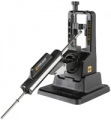The smallest grit provided in the design of the sharpener or among the complete replacement whetstones. It also indicates the standard grain size for models that have only one type of abrasive surface.
The universal unit for grit is GRIT. Simplified, GRIT grit can be described as the smallest number of holes per square inch of a sieve, at which individual abrasive grains can no longer wake up through this sieve. Accordingly, the higher the GRIT number, the finer the grain will be and the lower the granularity will be.
The purity and intensity of sharpening directly depends on this indicator. The finer the grit, the finer the finish and the lower the abrasive performance, and vice versa, coarser surfaces are well suited for initial sharpening, roughing and/or removing large amounts of material.
Here is a rough table of recommendations for optimal GRIT grit for different applications:
80 – 600 — peeling work (for example, correcting the thickness or geometry of the cutting edge or the entire blade).
600 – 3000 – preparatory work (elimination of traces of peeling), initial sharpening.
3000 – 6000 – semi-finish and fine sharpening.
More than 6000 – final finishing, polishing, straightening of the cutting edge.
At the same time, it is worth remembering that the processing features also depend on the material of the abrasive (see above). For example, ceramic surfaces with
...the same grain size work more delicately and more slowly than diamond ones. More detailed recommendations on optimal grit values and the specifics of various materials can be found in special sources.Possibility of using a sharpener for
sharpening serrated blades.
Such blades have a serrated cutting edge, for which the classical method of sharpening, on a flat surface, is unsuitable: such a procedure will simply erase the teeth and, at best, turn the serrated blade into a classic smooth one. Therefore, for sharpening in this case, special devices are used: thin rods made of abrasive material, somewhat tapering towards the end. With such a rod, each individual tooth is sharpened separately; this work can be quite laborious, but it allows you to restore the full performance of the serrated blade. At the same time, note that for blades with fine teeth, even such a specialized sharpener may be too large.
Possibility of using a sharpener for
sharpening scissors.
Technically, you can sharpen scissors on almost any sharpener — the design of their blades is not very different from knife ones. However, individual sharpeners may provide various design solutions that make it easier to work with scissors — for example, the ability to set the optimal sharpening angle or special mounts for such a tool. Therefore, for maximum convenience when working with scissors, you should still choose models where this function is directly stated.
Cover/case. Accessory for storing and transporting the sharpener, protecting the product from contact with surrounding objects, dust, moisture and other adverse factors. A cover can mean both a product made of soft materials and a small hard container for a compact model; case is usually called rather large boxes for advanced kits like machines (see "Type") or sharpeners such as Lansky (see "System"). Accordingly, the design features and the degree of protection may be different, the details should be clarified for each model separately. However, anyway, a complete case or case is much more convenient than an impromptu package.

